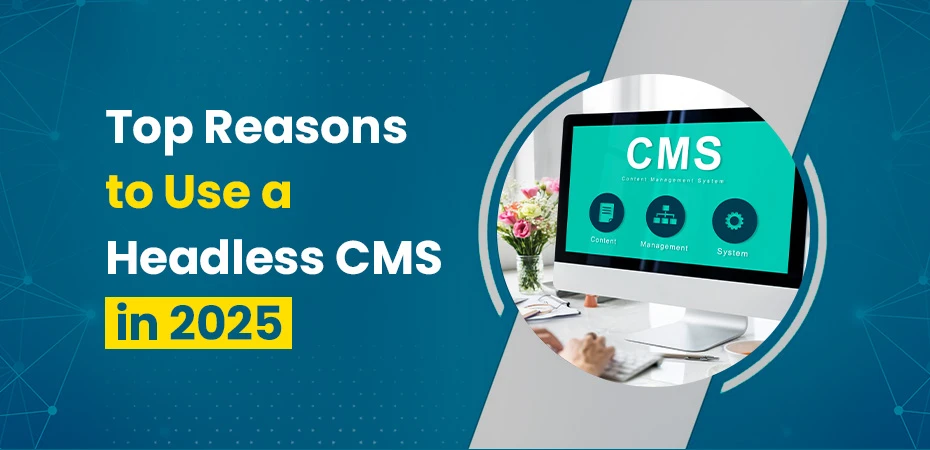Top Reasons to Use a Headless CMS in 2025



The structural foundations of digital content layout are continually evolving, thanks to the advancements in technology. The traditional, monolithic content management system that once ruled the world of content layout is challenged by a headless CMS. But why is this so, and should you follow the trend? In this article, we’ll explore the top compelling reasons to use a headless content management system and the benefits it offers.
Understanding the Concept of a Headless CMS
Simply put, a Headless CMS is a unique type of content management system. This software application provides a unique way to create and manage content. However, unlike traditional content management system , it does not limit your content to a certain output, such as websites, prints, etc. Instead, it allows the content to be available as data over an API, or Application Programming Interface.
This system allows for more flexibility as your content isn’t tied to a specific presentation layer. This gives developers the freedom to choose any front-end tool to display their content, according to their project’s specific requirements. This means that your content can easily be utilized anywhere.
Headless CMS might appear complicated at first, but they’re an essential technology to understand in today’s rapidly-evolving digital world. They are particularly beneficial for businesses and developers aiming to future-proof their content and provide a multi-channel user experience.
When we talk about SEO, or Search Engine Optimization, understanding Headless CMS becomes even more essential. The flexibility provided by a headless content management system can influence how your content is structured, potentially improving your SEO performance. You can delve deeper on how a headless CMS is related to SEO in this comprehensive guide.
Top Reasons to Use a Headless CMS
Let’s delve more into why choosing a headless Content Management System might be the best decision for your content management.
1. Multi-Channel Publishing
The prime advantage of a headless content management system is the flexibility it provides in content distribution. It allows seamless content repurposing across numerous channels apart from your website, including mobile applications, IoT devices, smartwatches, and digital kiosks.
2. Flexibility & Freedom for Developers
Traditional CMS require developers to use specific pre-packaged templates. A headless Content Management System doesn’t come with such limitations. It grants developers the freedom to create bespoke front-end layouts using the technologies and frameworks they prefer, leading to truly fast and high-performance websites.
3. Enhanced Security and Performance
Headless CMSs minimize security threats brought about by traditional CMSs. Since there’s no rendering front-end or plugins, the attack surface is considerably lowered. Furthermore, using a content delivery network with a headless content management system can boost the loading times of your web pages, thus improving site performance.
4. Better Previews and Seamless Updates
Headless content management systems facilitate real-time content preview – something traditional CMS’s cannot deliver. Additionally, system updates and adding functionalities are much simpler with a headless Content Management System than with a traditional CMS.
5. Enables Scalability
A headless CMS provides room for scalability as your business grows. Its flexible architecture ensures it can handle increased traffic loads efficiently while maintaining superb site performance. Discover more on how to enhance your site’s crawl efficiency and maintain scalability.
The Shift from Traditional CMS to Headless CMS
The traditional CMS, although successful in its heydays, failed to adapt to the exponential surge of digital platforms and formats. Unlike a traditional one, a headless CMS is free from the limitations of a predefined front-end system and instead, provides a ‘front-end agnostic’ content repository that delivers content via APIs (Application Programming Interfaces) to any platform or device. This fundamental architectural difference makes headless content management system a top priority for digital-first businesses.
1. Omnichannel Delivery
In an era where customers expect seamless experiences across all touchpoints, a headless CMS shines through its promise of omnichannel consistency. It’s built to provide content that is ‘write once, publish everywhere’ – across websites, mobile apps, e-commerce platforms, IoT devices, and more. This ensures a consistent, continuous, and personalized customer journey, which ultimately drives engagement and conversions.
2. Increased Flexibility
With an API-first approach, a headless Content Management System provides greater flexibility to developers. They have the freedom to design the front-end using their preferred technology, without any dependency on the backend content management system. This leads to scalable, flexible, and faster project rollouts. For more insight, refer to the page on the fastest web development tools: ultimate guide for 2025.
3. Superior Scalability
As organizations grow, their content requirements change radically. A headless CMS system is inherently scalable because of its modular architecture, which means companies can effortlessly manage content across myriad platforms, irrespective of the volume or type of content
4. Enhanced Performance
Due to the separation of the front-end and the back-end, a headless CMS allows simultaneous progress on the design and content, leading to a quicker time-to-market. More importantly, since the front-end is powered by lightweight APIs instead of heavy monolithic constructs, the website performance is significantly enhanced, thereby boosting SEO. Read more about the SEO implications at our webpage on Technical SEO vs Content SEO.
Future-Proof Content Management with Headless CMS
1. Ultramodern Content Strategy
The core strength of headless CMS software lies in its versatility. “Content” is just raw data until it is rendered on a front-end display. The API-first design of headless CMS transforms this raw data into a format friendly to every type of front end, be it websites, apps, IoT devices, or wearables.
2. Absolute Frontend Freedom
Headless CMS do not predefine how and where to display content. Developers have full autonomy to design a custom front-end while Content Management System focuses on storing and delivering structured content. This enhances the creativity and the overall user experience.
3. Seamless Integrations
The API-driven architecture of headless Content Management System allows easy integration with any system, offering more flexibility in building your tech stack. From CRM and ERP systems to marketing automation and e-commerce platforms, headless CMS can sync with a multitude of services.
4. Scalability
Headless CMS are cloud-first, allowing automatic scalability according to the traffic flow. This offers enterprises the freedom to grow without worrying about building and maintaining an infrastructure.
5. Enhanced Security
With decoupled architecture, a security breach on the presentation layer does not affect the content management layer, protecting your critical business and customer data.
6. Faster Delivery
A traditional one requires developers to adjust content to fit multiple platforms, a process that consumes time and resources. On the contrary, headless content management system allows quick and easy content repurposing for any output type.
Challenges Posed by a Headless CMS
Despite its advantages, a headless CMS presents its own set of challenges. The absence of a front-end system implies you need technical expertise to configure the presentation layer. Further, the initial setup cost may be higher than that of a traditional CMS. However, the long-term benefits and convenience often surpass the initial setup challenges and costs.
Conclusion
A headless CMS offers multiple features that are beneficial to businesses, developers, and end-users. Its benefits, such as multi-channel publishing, flexibility & freedom for developers, enhanced security and performance, better previews & seamless updates, and scalability, make it a preferable choice for many businesses regardless of the size.
However, it’s not without its challenges. For this reason, while considering an upgrade, it’s important to weigh the opportunities against these challenges. It’s advisable to assess your specific business needs, objectives, and the technical expertise of your team before deciding if a headless CMS is the best fit for your business.
Frequently Asked Questions (FAQs)
A headless CMS is a back-end only content management system built as a content repository. It makes content accessible via an API for display on any device, without a built-in front-end or presentation layer.
You should use a headless CMS for reasons such as flexibility in design and content presentation, multi-channel publishing, enhanced security & performance, seamless updates, and scalability. Check out our full article for detailed explanations of these benefits.
The challenges of a headless CMS may include the need for technical expertise for configuring the presentation layer and potentially higher initial setup cost. Nevertheless, the long-term benefits usually outweigh these challenges.
A headless CMS facilitates the creation of faster, more responsive websites that are preferred by search engines, thereby potentially improving SEO rankings. For more insights, check our complete guide on Technical SEO vs. Content SEO.
The future of CMS is geared towards more flexible and scalable solutions like headless CMS. The global CMS market is projected to reach $123.5 billion by 2026, with a considerable portion attributed to the implementation of headless CMS solutions.